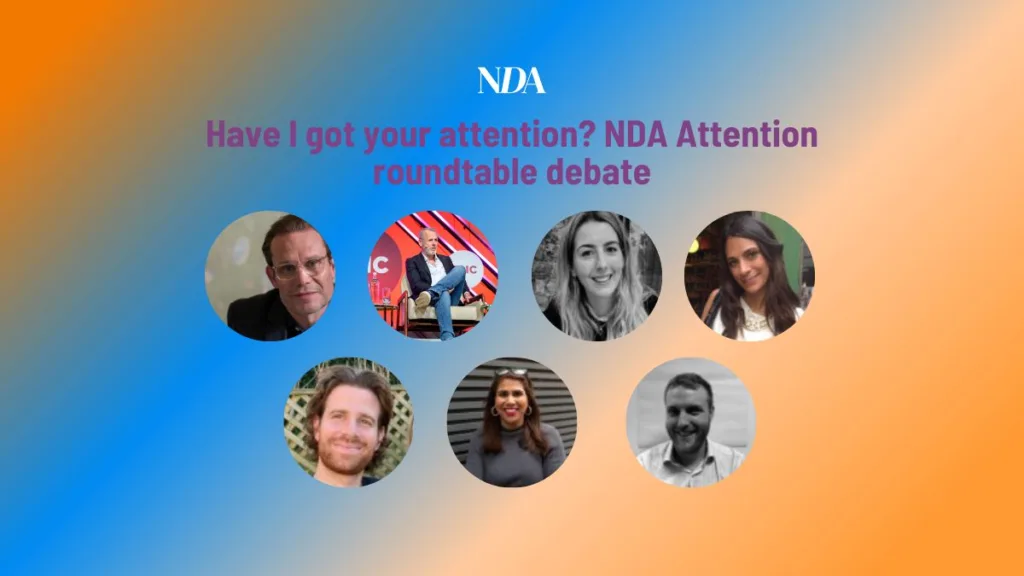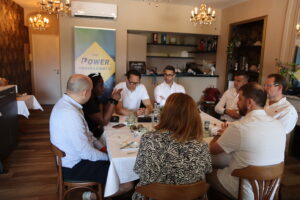Does it really matter if a customer doesn’t ‘engage’ with your ad? With viewability determined by just a handful of pixels or just a second’s glance, are the ads that are viewed really ‘seen’. Instead of getting in front of eyeballs, advertisers are asking themselves if they shouldn’t be aiming higher or, in this case, deeper. How do they get beyond the cornea and into the brain? How do we get from viewable, to attention? And if we do, is the effort worth it and how do we prove it?
With all of the questions and at least some of the answers, NDA Editor Justin Pearse convened a roundtable of ad industry experts to chew over the tricky matter of attention, who needs it, how they get it and if they did, was it worth it. Featuring Sophie Strong, Managing Partner of Media Experience, PHD UK, Lina Angelides, Head of Programmatic, OMD UK, Justin Reid, Director of Media, Destinations, Hotels and Growth, Tripadvisor, Ross Coombes, Programmatic Commercial Director, Mindshare, Mike Follett, Managing Director, Lumen Research and Maya Tank, Senior Client Partner at DoubleVerify, we explore the advertiser’s attention economy.
Addressing the elephant in the room straight away, Strong simply asks: “If an ad isn’t seen and isn’t experienced, then why have we paid for it?” It would seem that there is a very low bar of expectation set for digital ads and, with the imminent demise of the cookie, the very real possibility that online advertising will contribute even less to ROI. It could, however, also be a turning point.
Tank points out that attention is important right now “because it’s moving the dial from intent into action” although, she admits, “slowly”.
“Attention measurement fits quite nicely with the fact that we’re starting to look at how all the digital channels work together,” Coombes suggests with Lumen Research’s Follett adding that, with the cookie now effectively dead and other targeting options no longer available (such as iOS) “ads that are optimised for attention work better.”
“Viewability builds on a standard that’s been adopted by the whole industry” Coombes explains. “People have realised it isn’t good enough to determine anything. Attention takes it one step further to say how users are engaging with it, rather than whether they just saw it. You would assume that the higher the attention, it should drive better outcomes across the board.”
It’s not just about grabbing people’s attention, it’s a two-way process. Follett suggests that attention data gets better results, informing where you advertise and what creative to use. Strong elaborates: “It’s a lever that allows us to get a bit deeper into how we connect with individuals. But we can also learn about what makes people want to spend time with us.” She adds that it is necessary today because, with vanishing targeting data, if ads aren’t optimised they’ll become less effective over time.
However, it is also a tactic to be approached with caution. It cannot, in itself, become the whole story. Tripadvisor’s Reid has a timely warning: “The danger is that clients start talking about attention and it becomes more important than another metric. Are we diluting what the overall proposition is? Let’s talk about the metric being effective advertising, and then what makes that. That’s what as a brand and as a publisher, would get us most excited about.”
As with all new(ish) ideas, it’s a bit of a Wild West initially. The roundtable participants acknowledge that one person’s attention is not necessarily another’s valuable engagement. “We don’t have an industry framework for attention right now,” Tank warns. “No standardised idea of what it should look like. We need to establish what that is. Attention is also made up of different indices that factor into two pillars – exposure and engagement – then lead into your brand KPIs.”
In addition, the multiple stakeholders in the advertising ecosystem make it difficult to arrive at a consensus. Follett describes the difficulty of one organisation being able to state that a model will be accurate with 100% certainty, due to ‘black holes’ in insight created by other parties.
“We have got really good at predicting attention to media but even our model is only 70% accurate. The bit that is missing is that 30% of our predictions is tied to the creative, which publishers don’t control. It’s a really interesting tension that no-one controls the whole story. If I was on the sell side, I definitely want to control what’s appearing on my website,” he states.
Strong agrees, suggesting that it’s down to the partners involved in a media campaign to open a dialogue so they can optimise with the best possible information. “We need partners to give us guidance on what good looks like. I expect that from a partner. It’s also an opportunity for creative agencies to enter a conversation that they hadn’t been as close to before.”
Both Coombes and Tank agree that there are many variables that can impact attention. The former asks if an ad was delivered by “eye-catching creative” or just influenced by the media placement. Tank asks about creative optimisation such as if the ad is viewed with the sound turned off, or the screen rotated.
OMD UK’s Angelides brings up the question of consumer intent which can have a huge impact on how much attention an ad is likely to garner. Quite simply, what are they doing online at the time and is it conducive to being advertised to. What she reveals is that it is not always straightforward.
“It’s really difficult to determine what the user is using the internet to do at the time. Someone on National Rail Enquiries might give an ad attention but for a different reason. It’s being noticed, but it’s really difficult for the buy side to determine the attitude of the user.
“From a performance marketing perspective it’s difficult to get penetration if you’re wanting someone to engage with an ad but they’re busy booking a holiday or following a recipe. In some studies, we can correlate attention to click through rate, but we don’t see one when we map it back to conversions. How do we target based on attention when we don’t know if the user is ready to pay attention, or not?” she asks.
In the second part of our attention special, published later this week, our participants delve deeper into attention measurement and metrics, exploring what it means to truly understand the contribution this new and hotly debated tactic makes to the bottom line.








